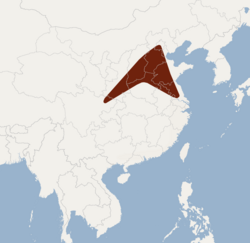Beijing mouse-eared bat
Species of bat From Wikipedia, the free encyclopedia
The Beijing mouse-eared bat or Peking myotis (Myotis pequinius) is a species of vesper bat. It is found only in China.
| Beijing mouse-eared bat | |
|---|---|
| Scientific classification | |
| Domain: | Eukaryota |
| Kingdom: | Animalia |
| Phylum: | Chordata |
| Class: | Mammalia |
| Order: | Chiroptera |
| Family: | Vespertilionidae |
| Genus: | Myotis |
| Species: | M. pequinius |
| Binomial name | |
| Myotis pequinius Thomas, 1908 | |
 | |
Taxonomy
It was described as a new species in 1908 by British zoologist Oldfield Thomas. The holotype had been collected by Malcolm Playfair Anderson in 1907. Anderson encountered the species in a cave 30 mi (48 km) west of Beijing.[2]
Description
It is a relatively large mouse-eared bat with a forearm length of 48–50 mm (1.9–2.0 in). Its fur is short and velvety, with the fur on its back a gray, reddish-brown. In contrast, its belly fur is off-white.[3]
Biology and ecology
It is insectivorous, consuming mostly beetles.[4] During the day, individuals roost in caves, though they may also roost in human structures.[1]
Range and habitat
The Beijing mouse-eared bat is endemic to China, where it is found in the provinces of Anhui, Beijing, Henan, Jiangsu, Shanxi, and Sichuan.[1]
Conservation
As of 2019, it is evaluated as a least-concern species by the IUCN. It meets the criteria for this classification because its extent of occurrence exceeds 20,000 km2 (7,700 sq mi); its population is presumably large; and it is unlikely to be experiencing rapid population decline.[1]
See also
References
Wikiwand - on
Seamless Wikipedia browsing. On steroids.

